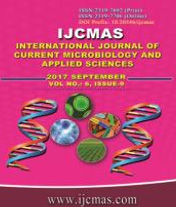


 National Academy of Agricultural Sciences (NAAS)
National Academy of Agricultural Sciences (NAAS)

|
PRINT ISSN : 2319-7692
Online ISSN : 2319-7706 Issues : 12 per year Publisher : Excellent Publishers Email : editorijcmas@gmail.com / submit@ijcmas.com Editor-in-chief: Dr.M.Prakash Index Copernicus ICV 2018: 95.39 NAAS RATING 2020: 5.38 |
Corneal ulceration is a leading cause of ocular morbidity and blindness worldwide. India being an agricultural land, corneal trauma leading to rapidly progressing corneal ulceration is very common. Many studies have been published on corneal ulcers all over the country but no study has been published from rural part of Haryana. Therefore this study was undertaken to find the rate of bacterial and fungal isolates in corneal ulcers and to assess their clinical epidemiology. The present study was carried in the Department of Microbiology, MMIMSR, Haryana on 200 clinically suggested cases of corneal ulcers. Corneal scrapings were subjected to microscopy and culture. Of 200 suspected cases, 43.5% were culture positive. Staphylococcus aureus and Pseudomonas aeruginosa were the predominant gram positive and negative bacterial isolates. Aspergillus species was the most prevalent fungal isolate. Ocular trauma and tropical steroids was the commonest predisposing factor. Sugarcane leaf trauma was the commonest vegetative origin trauma. Redness, blurred/diminished vision was most commonly seen in fungal keratitis while pain, redness was most commonly seen in bacterial keratitis. The clinical presentations of bacterial and fungal corneal ulcers are often overlapping and confirmation by microbiological testing is essential for better treatment.
 |
 |
 |
 |
 |